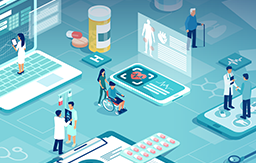Artificial Intelligence (AI) tools are being introduced and used in every industry, and health care is no exception. AI is emerging as a possible tool to help improve patient outcomes, streamline provider operations, and control costs, but not everyone is eager to embrace it.
That’s why these technologies must be implemented responsibly. AI is best understood as a useful tool in the health care toolkit rather than a replacement for human expertise.
HR professionals, brokers, and business owners can all benefit from understanding how AI is currently being used in health care, what may be on the horizon, and what risks there are. Staying informed is essential for helping members navigate the evolving health care landscape.
Real-World AI Applications in Health Care
AI is already being used in health care facilities to improve the efficiency of administrative workflows.
In a video about generative AI in health care, Dr. Eric Bricker from AHealthcareZ shares that a whopping 62% of doctor time is spent with a patient’s electronic medical record rather than with the patient. AI can help streamline documentation, reducing the burden of administrative tasks and freeing up time for patient care. DeepScribe is one company that offers this AI-powered service.
It works by pairing an ambient listening device (think Amazon’s Alexa or Google’s Dot) in the office with natural language processing models with voice recognition. Integrate that with a generative AI large language model (LLM), and you have an automated system for recording patient care notes. According to Dr. Bricker, this can save doctors three hours per day!
LLMs (think of ChatGPT) can also write in a fraction of the time it takes a person to do it. Of course, medical providers must protect privacy, but doctors can use LLMs to compose letters to insurance companies requesting authorization to approve a given treatment for a patient.
The caveat here is that models like ChatGPT are typically trained using older information, so the latest research and treatment isn’t always included. Doctors have to check to ensure the results are accurate and may need to add updated research. Even so, LLMs stand to save precious time for busy health care providers.
There are a host of other use cases for AI systems. Medical professionals can use them to review and summarize lengthy medical records to get up to speed faster in busy environments like emergency rooms. Machine learning algorithms can also be used to help identify billing errors, and detect potential fraud, saving both providers and employers valuable resources. AI screening tools are also able to identify problems earlier, when treatments can be more effective.
Predictive Analytics Support Cost Containment Strategies
One of the most promising applications of AI is predictive analytics. By analyzing huge amounts of historical claims data, demographic information, and clinical metrics, AI can identify unique patterns and trends quickly.
Benefits administrators can then use that information to:
- Forecast high-cost claims before they occur
- Identify members who may benefit from early intervention programs
- Optimize provider networks based on quality and cost metrics
- Target wellness initiatives to the populations that are most likely to benefit
The Human Touch: Our Approach to AI Integration
At CDB, we firmly believe that while AI offers valuable insights, health care decisions ultimately require human judgment and compassion. That’s why we don’t rely on an algorithm to process claims. Instead, a qualified human expert reviews claims to determine the best course of action.
AI tools are useful to help process data, but the final decisions about benefits and interventions always rest with our trained specialists who understand the nuances of each member’s situation. Our balanced approach allows us to harness the efficiency of automation while ensuring that empathy and human judgment remain at the center of our benefits administration.
